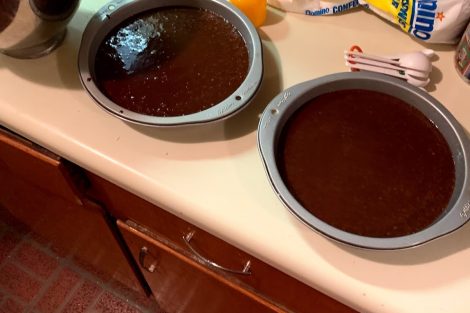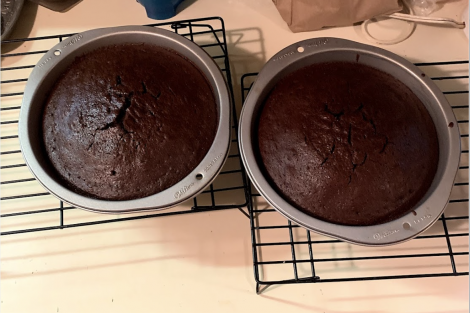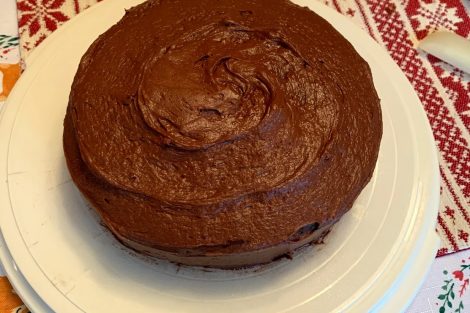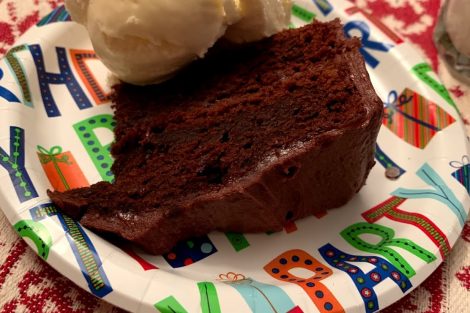
Purposes of Ingredients
All-Purpose Flour – Includes starch and gluten-forming properties which allows it to keep all of the ingredients together
Sugar – Adds texture, and caramelizes which adds the ever-important sweetness to the cake
Cocoa powder – Chocolate flavor
Baking powder and baking soda – Leavening agents. These are used to release gases inside the cake so as to gain a nice rise.
Salt – Enhances the sweet flavor of the cake
Sour cream – Sour cream is used in baking to create thickness, to brown the cake, to aid in baking soda activation, and for the richness of flavor
Milk – Addition of fat and liquid
Coconut oil – Addition of fat
Large eggs and egg yolks – These work to keep the ingredients intact, and are also used for added fat. Yolks have the most fat in the eggs, so they are needed more than the egg whites
Butter – Adds fat, richness to flavor, and keeps all of the ingredients combined
Vanilla extract – To enhance the chocolate flavor
Strong hot coffee – To enhance the chocolate flavor
Frosting:
Butter – Adds fat to contribute to both fluffiness of frosting and firmness.
Chocolate – Chocolate flavor
Confectioners’ sugar – Sweetness
Half and half – This type of cream includes fat to add air and fluffiness, but not enough to be a full foam.
Vanilla extract – Enhance the chocolate flavor
Why do I have to separate the dry ingredients from the wet ingredients?
I have always wondered why, in cake recipes, one needs to separate the dry ingredients from the wet ingredients. When baking while growing up, it seemed wasteful because I would have to wash multiple bowls after finishing the recipe. It wasn’t until this class that I learned that the reason behind the necessity of separating dry and wet ingredients. One has to disperse the leavening agent evenly throughout the batter so as to have an even rise. This has to occur before the leavening agent touches a liquid because it will cause the agent to react.
What type of pan is best?
As far as cooking devices go, I suggest you use a moderately-colored reusable aluminum pan. This will give the cake a perfect medium in terms of coloration; not too dark, but not too light. For a chocolate cake this can be useful, because if you use too dark of a pan, then the cake could result in a burned color. Medium-colored aluminum will reflect some of the infrared radiation but will absorb the majority of it, which will be perfect for your cake.
Can I just use baking soda?
If you would like to experiment with leavening agents, I suggest you substitute baking powder for baking soda with an additional source of acidity. Baking powder and baking soda are generally used in baking so that you can gain two different levels of leavening reactions. However, not everyone will have both baking powder and baking soda in their kitchen, so it might be useful to use only baking soda. For this substitution, you add the regular amount of baking soda; 1 ½ tsp. Then, to switch in baking soda for the baking powder, use three times less baking soda, as it calls for baking powder. This amounts to ⅔ tsp of baking soda. In addition, you need one teaspoon of acid (we will use cream of tartar) for every ½ teaspoon of baking soda. This means that you need 1 ⅓ tsp of cream of tartar. All together, instead of using baking soda and baking powder, you will use 1 ⅙ tsp of baking soda and 1 ⅓ tsp of cream of tartar.
If you would rather use a recipe card, click Here!
If you would like to learn more about the author, click Here!
Ingredients
-
Cake
- Frosting
Instructions
-
Cake
- Preheat oven to 350 degrees Fahrenheit, and then butter and lightly flour two 9-inch pans.
- Whisk flour, sugar, cocoa powder, baking powder, baking soda, and salt in a large bowl until combined thoroughly.
- Add milk and sour cream to the mixture and beat on medium-high speed.
- Add coconut oil, eggs (with egg yolks), melted unsalted butter, and vanilla extract to the mixture. Beat on medium-high speed.
- CAREFULLY Add coffee into batter and beat on medium-high speed.
-
Distribute batter evenly between two prepared cake pans.

- Bake for 45 minutes or until toothpick comes out clean.
-
Cool for 10 minutes, then remove from pan and cool completely.
 Frosting
Frosting
- Melt butter and chopped unsweetened chocolate in a heavy saucepan over low heat, stirring constantly. Then remove from heat and cool for 5 minutes.
- Beat confectioners' sugar, half and half, and vanilla extract until smooth.
- Beat chocolate mixture into frosting until light and fluffy. Assembly
-
Spread frosting between layers, over top, and on sides of the cake.

-
Decorate and enjoy!

Notes
Bibliography
All pictures used were taken by Hannah Youmans and family
Bauer, E. (2019, November 26). The Difference Between Baking Soda and Baking Powder. Retrieved May 6, 2020, from https://www.simplyrecipes.com/the_difference_between_baking_soda_and_baking_powder/
Matsumoto, K., Scienchef, Matt, & Fogerty, D. (2020, April 18). Why and How Sour Cream Is Used in Cakes ( Recipe). Retrieved May 6, 2020, from https://foodcrumbles.com/why-how-sour-cream-used-in-cakes-science/
Bilow, R. (2017, May 30). Everything You Need to Know About Coconut Oil. Retrieved May 6, 2020, from https://www.bonappetit.com/test-kitchen/ingredients/article/cooking-with-coconut-oil
Angus. (2014, October 31). Super Decadent Chocolate Cake with Chocolate Fudge Frosting. Retrieved May 6, 2020, from https://completerecipes.com/super-decadent-chocolate-cake-with-chocolate-fudge-frosting.html
Hotton, E. (2016, November 23). Baking Ingredients & Function: A Breakdown. Retrieved May 6, 2020, from https://ueat.utoronto.ca/baking-ingredients-function/
Hamel, P. J. (2017, March 10). Baking cake in a dark pan. Retrieved May 6, 2020, from https://www.kingarthurflour.com/blog/2017/03/10/baking-cake-in-a-dark-pan